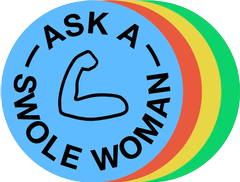Illustration by Elnora Turner
Sick of clean eating, perfect gym outfits, and chiseled abs? A Swole Woman is here to help you be healthy, enjoy carbs, and get jacked.
Advertisement
You know I love a fridge magnet aphorism, so let’s cue one up: Being an athlete is not never getting injured, but learning to manage your injuries. This is not a terribly visible part of sports, but pain and injury management—not cures—are an absolutely enormous part of it. Most athletes you see on any field or court are just a jumble of physical ailments, kept at a low-enough simmer to allow them to play. Similar is true of most people who have been strength training a long time; if you are able to, say, squat 600 pounds and have never endured some sort of acute or developing chronic pain, you are an incredibly rare person. Sometime pain comes from doing something wrong, unintentionally or intentionally; sometimes it comes from the way bodies are built or how they change over time. Pain is not an indictment of any given person. It’s important to know this because it should inform our overall approach and understanding of how we manage or mitigate pain.
Advertisement
Advertisement
Perhaps your PTs prescribed this approach, in which case, I guess listen to them and not me. Except that I must point out that even with apparently lots of core work, you’re still having back pain issues. If a PT’s advice or prescription didn’t help you, and they especially didn’t help you after you flagged the ways in which you are still having pain, you should feel empowered to seek a second opinion. I want to put a word in here for two other professionals whose guidance have helped me: sports medicine doctors, and actual strength training coaches.Everyone is familiar with the exchange where you say, “doc, it hurts when I do this,” and the doctor says, “stop doing that”—a joke format, but also a real thing that doctors mysteriously do a bunch of times each day. No shade to doctors; I believe that many are excited and thrilled about the beautiful complexity of the human body, and are just fatigued from trying to explain it to people who don’t care. But if you are a person who does care, a sports medicine doctor might be a better match for your growth-mindset attitude to your body. A sports medicine doctor, in contrast to a regular PCP, is focused on helping people continue to move despite their aches and pains. You don’t have to be a world class athlete to go to a doctor like this, and I have found them to be, on average, more solutions-oriented than the average PCP. Their job is not just to solve your pain and problems, but to help you continue to move. A regular doctor, in my opinion, should also be focused on this. But often they are not.
Advertisement
I think also, on a softer note, a strength training coach may be able to give you a more holistic understanding of your body and the role of “your core” and your lower back in how you move. I highly recommend reading this old Daniel Duane story, which is in large part about the strength training gym Mountain Athlete and the coach who ran it, who died with several students in deep emotional gratitude to him for how he repaired their actual injuries and relationships with their bodies. This story also presents strong case that, even if you have low back pain but weren’t looking to start whole body strength training, it might help in ways you don’t even realize (yes, in part by working your core, but also much more than that).
Advertisement
Finding a coach can be a little tricky, I admit. But if you’re in an area that’s not exactly densely populated with powerlifting gyms, there are plenty who offer their services online (in-person sessions will undoubtedly be better, but, pandemic and all, sometimes we have to take what we can get). I’d strongly suggest checking out the coaches of strong people you follow, and perhaps see if those coaches are part of a bigger staff, or if there are other coaches those coaches talk about. There’s no foolproof strategy, but just like with working out, don’t set the bar too high. If you absolutely can’t open yourself to a strength training coach, or to costs too much, you have to become an absolute student of body mechanics and form. This will likely involve beginning from zero: You can no longer assume just based on looking at a photo of someone doing a movement like a plank that you know the right way of doing it. You have to actually look up what it should feel like, what you should be doing with all the parts of your body, and strive to do it correctly. This is definitely trickier and slower than than having a coach, because a coach can help you hone in on what your personal challenges are, but becoming a good-form monk is definitely better than charging ahead as if you already know how to do everything. I say this as someone who went her whole life thinking I knew how to do a pushup, and now that I can bench 140 pounds, I know that I barely know how to do a proper push-up at all.
I’m proud of you for wanting to push through (though, as always, be gentle). There are people and a community who will understand your commitment to the swole way of life; it might just take a bit of legwork to find them. Disclaimer: Casey Johnston is not a doctor, nutritionist, dietitian, personal trainer, physiotherapist, psychotherapist, doctor, or lawyer; she is simply someone who has done a lot of, and read a lot about, lifting weights.You can read past Ask A Swole Woman columns at The Hairpin and at SELF and follow A Swole Woman on Instagram. Got a question for her? Email swole.woman@vice.com.

